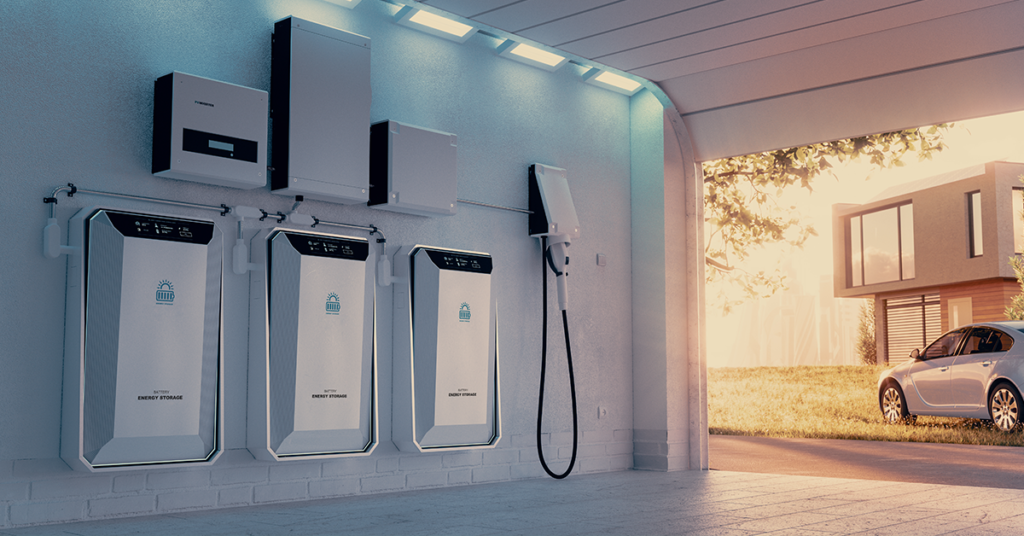The Benefits of Solar Power. Energy is something the world and its population rely on to live and function. Every time we turn on a light, plug in appliances, etc., we’re using energy. That energy can come from non-renewable sources or renewable ones. Solar power is the most abundant and easily accessible form of renewable energy.
But before diving deep into the details on solar power and its benefits, it’s important that we first go over the different types of energy, and their general forms and uses.
Renewable Energy
Renewable energy is energy that we can take from Earth’s naturally occurring resources . Basically, renewable energy sources are inexhaustible, meaning humans won’t be able to deplete them because there isn’t a finite store of them. It’s common to refer to renewable energy as clean energy, sustainable energy, or green energy.

We’re seeing more and more how valuable renewable energy is. Not only is renewable energy inexhaustible, it’s also not harmful to the environment. Solar power, for example, doesn’t release harmful emissions such as carbon dioxide.
Needless to say, renewable energy is greatly beneficial to the environment, and can even slow climate change.
Types of Renewable Energy
The main types of renewable energy that humans make use of are solar energy (power), wind energy, and hydropower. These resources are abundant, easily accessed, and harnessed for human use.
The sun is always shining somewhere, just as the wind is always blowing. This means that renewable energy is available to humans in every part of the world. A fascinating fact about the energy given off by the sun is that the amount of sunlight hitting the Earth in one hour gives off more energy than the entire world could use in a year.
Uses of Renewable Energy
The primary use of renewable energy is to provide power in the form of power or electricity. For example, your rooftop solar panels are constantly receiving the sun’s rays and storing that energy, and then converting it into a usable form.
Once the rooftop solar panels have converted the sun’s energy into a useable form of energy, or electric current, that energy is ready to power everything in your home, from tv’s and appliances, phones, cars, even hot water.
Nonrenewable Energy
Unlike renewable energy which is infinite and inexhaustible, nonrenewable energy is a finite fuel source, which means it’s impossible to replace it.
Nonrenewable energy sources are also known as fossil fuels. Millions of years ago, when plants and animals died and decomposed into the ground, those remains were fossilized and eventually became what we now know as fossil fuels. Needless to say, we can’t create more of these.

In order for humans to access these fossil fuels, they have to be dug up from the earth. The digging not only damages the earth’s surface, like in the case of strip mining, but all the heavy equipment used releases dirty, dangerous particles into the air.
Another huge issue with nonrenewable energy sources is that in order for humans to use them, they have to be burned. It’s this burning that then emits carbon dioxide and other harmful greenhouse gases into the atmosphere. This is one of the biggest contributors to the problem of global warming.
Types of Nonrenewable Energy
The most common types of nonrenewable energy are coal, gas, and oil.
Uses of Nonrenewable Energy
Nonrenewable energy is used by humans to create and provide energy, power, etc. We use it to make gas and diesel to power vehicles; it’s used in massive production plants; we use it to heat our homes; cook food. The list is really endless.
Greenhouse Gases
As we mentioned above, nonrenewable energy sources are also called fossil fuels, and are responsible for much of the greenhouse gas emissions that are damaging the environment.

Greenhouse gases are naturally occurring, meaning that they’re already present in the atmosphere. However, where they become problematic is when they’re released as a byproduct of burning fossil fuels (nonrenewable energy) in order to make energy for human use.
Types of Greenhouse Gases
Methane, carbon dioxide, and nitrous oxide are all naturally occurring greenhouse gases. On their own, these gases aren’t necessarily bad; it’s when they’re released as a by product of burning fossil fuels that they become truly harmful.
The most abundantly emitted greenhouse gas is carbon dioxide, which ends up making up 767% of the emissions created by humans. It stays in the atmosphere anywhere from 300 years to 1,000 years. You can imagine the negative impact that will have on the environment and even human health.
Methane is the other big player in terms of damaging greenhouse gases. Though it only accounts for 16% of the emitted greenhouse gases, it’s many times more harmful.
Benefits of Solar Power
We already said that solar is the most abundant form of renewable energy out there. Solar energy is always being emitted, as the sun is always shining somewhere in the world. Even on cloudy days, your solar panels are still absorbing the energy emitted by the sun.
Solar power is also one of the cleanest forms of energy out there. In addition to being extremely clean, using solar energy to power your home can be a financial boon. You can expect pretty impressive financial savings.
Solar Power is Good for the Environment
Solar power is one The EPA (Environmental Protection Agency) released a study saying that electricity use and production makes up 27% of the carbon emissions in America. That’s a lot! By using rooftop solar panels to power your home, you’ll be contributing to the reduction in harmful greenhouse gas emissions.

Solar panels help to reduce your carbon footprint. Once you’ve gone solar, your rooftop solar panels allow you to have enough electricity to power your home, all without having to use grid-tied carbon-releasing electricity.
Something incredible about solar panels is that a typical residential solar system has essentially the same environmental benefits as planting 100 trees each year. So your rooftop solar system is actually eliminating up to four tons of carbon emissions annually.
Solar Power Works Everywhere
As long as the sun is over the horizon, it’s giving off solar radiation. Since the sun shines for at least a few hours every day, everywhere, this means that the energy it gives off is technically accessible and available to be harnessed anywhere there are humans.
It’s automatically assumed that solar power and sunny climates go hand in hand. But where people are uncertain is if solar power works or makes sense in climates that are dark, cloudy, cold, rainy, snowy, etc. The answer is an absolute “yes!”
Solar panels work by passively capturing the sun’s radiation, or energy. That energy is then converted into an electrical current (electricity) that is then used to provide electricity and power to your home. So in summary, as long as the sun is over the horizon, there is solar energy to be harnessed.
Backup Solar Batteries
Often, when people have a solar system installed in their home, they will also put in a backup battery system. These batteries are key when it comes to storing excess solar energy collected by your solar panels.
As we mentioned above, solar power is a viable option regardless of the climate or region you’re living in. In extremely sunny climates, it’s a no-brainer to assume that there will be excess solar radiation that will need to be stored.

But it’s almost more important to have a backup battery storage system in a cloudy climate. This is because it’s common for there to be days on end during which the sun doesn’t come out from behind the clouds. So any and all excess solar energy that’s stored will be then used to power your home’s appliances, lights, heat the water, etc.
Backup batteries are also beneficial at night, since even though the sun isn’t shining, that doesn’t mean you’ll want your home to go dark and silent.
Another benefit of having a backup battery system installed is that in the case of a power outage, your home will still have power and your life won’t be interrupted. Nor will you have to pay to use electricity from the power grid.
Going Solar Means Saving Money
In addition to the environmental benefits of solar power, you’ll also see significant financial benefits when you install a solar system on your home or business. Here’s a list of some of the biggest money-saving benefits of going with solar power.
Solar Power Reduces or Eliminates Your Electric Bill
No one likes opening monthly electric bills, especially with the rising cost of everything these days. This is because instead of relying on the power grid to power your home, and therefore paying the associated high costs, your solar panels are passively absorbing the sun’s energy.

This passive absorption of the sun’s energy is a free process, meaning you won’t have to pay for it. Then, once that energy is absorbed, your solar panels do the work of converting the sun’s energy to energy that’s useable in your home or business.
People can choose to go fully solar, meaning they won’t rely at all on the power grid for their home’s energy needs. This will effectively eliminate their monthly electric bill, which is an extremely attractive option.
Other people choose to use both their solar system and also continue using the power grid. For example, you might use grid-tied electricity during the day, and then use the solar energy that’s been stored in your solar backup batteries for nighttime electricity use. Even in this case, they will see a significant reduction in their monthly electric bill.
Credits for Solar Power
Another money saving benefit of going solar is that in addition to reducing or eliminating your monthly electric bill, you can actually get money back. So how does that work?
Let’s say that your solar system produces more energy and electricity than your household needs or uses. You have the option of giving that surplus electricity back to the electric grid. The next month you’ll either see that surplus as a credit towards that bill, or you can opt to get money back in the form of a check or direct deposit.
Solar Power Combats Rising Energy Costs
The cost of electricity is increasing constantly, due in large part to the rising costs of commodities such as oil and gas. This means that if your home uses a regular, grid-tied power for electricity, you’ll be subject to ever-increasing electric and utility bills.
Your average rooftop solar panel will have a lifespan of about 25 years. So during your panels’ 25-year lifespan, you’ve essentially locked in a fixed rate on your electric bill, regardless if you are fully solar reliant, or still partially grid-tied.
Solar Panels Give a Great Return on Investment (ROI)
The purchase costs and installation fees for a rooftop solar system vary greatly. The cost will depend on the type of panels you choose, the number of panels you’ll need, the region you live in, your home’s energy and electrical needs, as well as who you choose to buy from, and who you have do the installation.
While the initial installation cost of a rooftop solar system isn’t cheap, it ends up paying for itself many times over, and in many different ways. The biggest way that your solar panels give you a great return on investment is the reduction in electric bills you’ll experience.
You can expect to see at least a 20% (and often much more) ROI from your solar panels. This is huge! Your solar panels end up paying for themselves in spades. The average rooftop solar system has a lifespan of 25-30 years, and you can expect your panels to have fully paid for themselves in about 5-10 years.
Federal Tax Incentives and Credits
The federal government offers a huge tax credit for homeowners who choose to go solar. In August of 2022, the federal government passed the Inflation Reduction Act which will pay for up to 30% of the installation cost of a rooftop solar system. The 30% federal tax incentive for going solar also applies to your purchase of a backup solar battery system.
The amount of your tax incentive will depend on which state you live in; some states offer higher incentives than other states. We’re going to give some numbers for Virginia, since Convert Solar is a Virginia-based company.
An average home solar system is about 6-kW. The cost of running a solar energy system in Virginia is 9.48 cents per kilowatt-hour. So that puts your solar panel starting cost for a 6-kW system at $15,780.
In general, Virginia residents can expect to see their solar systems come with a large price tag and installation cost. However, the huge tax breaks make it well worth it. The average tax break for a Virginia resident to go solar is $3,472 annually.
Decreased Installation Cost Make Solar More Accessible
Like we mentioned above, the cost of a solar installation is going to vary based upon a number of factors. But the overall installation cost, regardless of what region of the world you live in, is decreasing every year.
The average home solar system is 6-kW. Today, you can expect to pay somewhere between $11,340 – $13,860 for that type of system. Once your 30% tax incentive has been applied, you’ll be paying about 80% less than you would have paid 10 years ago.
One of the biggest benefits of this huge decrease in purchase and installation costs is that solar power is much more accessible and available to more people. The more people who can afford to install solar panels and be less reliant on the power grid means a massive reduction in greenhouse gas emissions. Talk about a great reason to go solar!
Solar Power Increases Your Home’s Value
Having a rooftop solar system installed on your home will actually increase its value. When you compare the prices of homes with solar panels and homes without solar panels, you’ll notice that the homes with solar panels are valued at about $20,000 more than their non-solar counterparts.
Zillow, one of the most popular home sales apps, says that homes with solar panels will actually sell 20% faster, and have their equity increased by 4% over those homes without solar panels.
Another way of looking at how solar panels increase the value of a home is to think of the panels as upgrades, rather like a remodeled kitchen with the highest-tech appliances. Obviously there are factors that will either increase or decrease a home’s sales value (such as the size of the solar system or the local area’s electricity rates). But it’s common knowledge that a home with a photovoltaic (PV) solar system will sell for more than one without.
Since a solar powered home gives you huge monthly savings on electric bills, it makes sense why it would sell for more!
Solar Provides Jobs
The benefits of going solar are undeniable. In addition to helping homeowners save money, increase their home’s value, get money back, and helping the environment, the solar power industry is also a goldmine for jobs. This boosts the local economy and helps individuals.
The Solar Foundation’s annual Solar Jobs Census released a study in which we learned that the solar industry is responsible for employing over 250,000 people. This is huge because it taps into the local job market and population, which in turn puts money back into the local economy.
